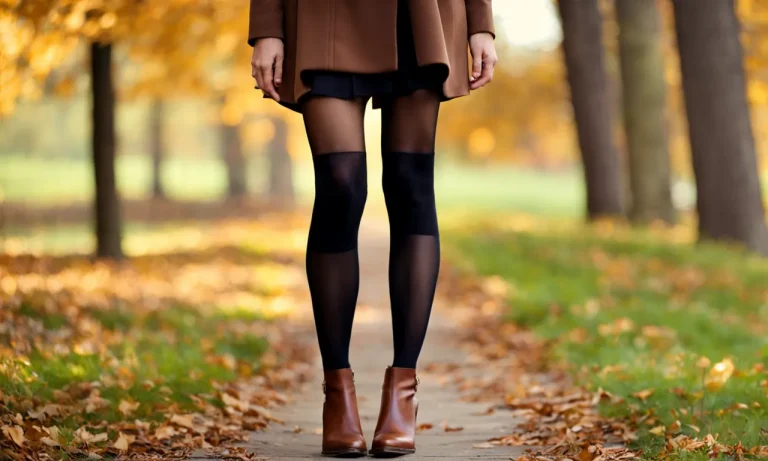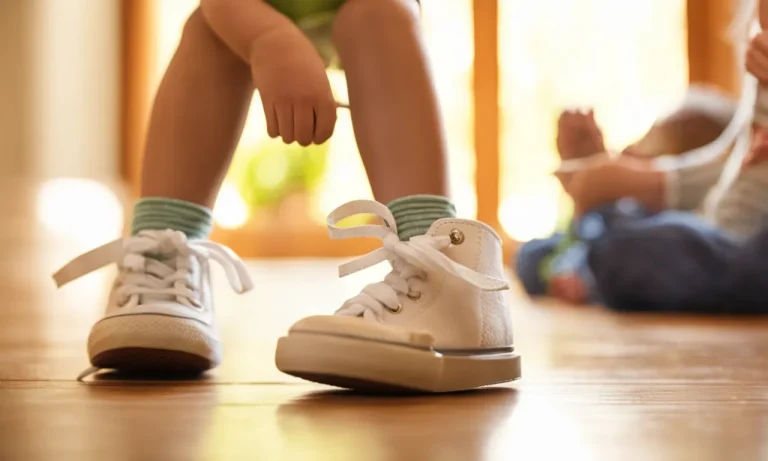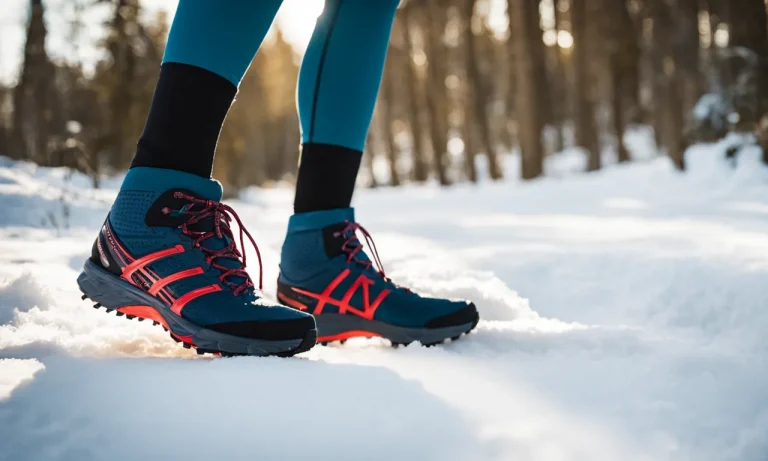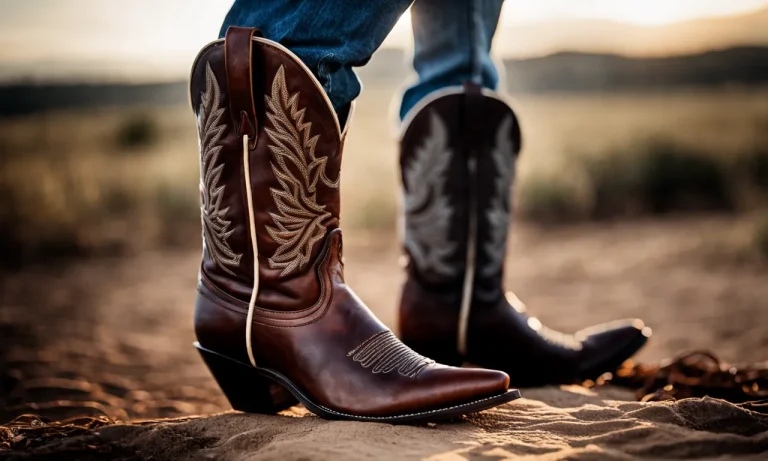Whether you’re an experienced hiker or just starting out on the trails, having properly fitted hiking boots is essential for comfort, safety, and performance. Ill-fitting boots can lead to blisters, instability, foot fatigue, and even injuries. So how do you know if your hiking boots fit correctly?
Read on for a detailed guide on getting the ideal hiking boot fit.
If you’re short on time, here’s the quick answer: Hiking boots should fit snugly with your heel locked in place, ample room for your toes, and enough space to wiggle your feet. The boots should not rub or pinch anywhere. Break them in gradually before hitting the trails.
Check for Heel Lock
One important aspect to consider when fitting hiking boots is the heel lock. The heel should not slip up and down when walking. To check for this, lace up the boots snugly and then walk around. If the heel slips up and down, it may indicate that the boots are too big or not the right fit for your feet.
A loose fit can lead to discomfort, blisters, and even injuries during long hikes.
Heels may be stiff at first but will break-in
It’s important to note that hiking boots, especially high-quality ones, may feel stiff and rigid when you first try them on. This is normal and often a sign of a well-constructed boot. The stiffness is due to the supportive materials used in the construction, such as a firm heel counter.
However, this stiffness will gradually diminish as you break in the boots by wearing them on shorter hikes or around the house. The boots will eventually mold to the shape of your feet, providing a more comfortable fit.
When purchasing hiking boots, it’s advisable to try them on in the afternoon or evening. This is because our feet tend to swell throughout the day, and trying on boots when your feet are at their largest can help ensure a proper fit.
Additionally, wearing the same type of socks that you would use while hiking can give you a better idea of how the boots will feel during your outdoor adventures.
Remember, a well-fitting pair of hiking boots is essential for a comfortable and enjoyable hiking experience. If you’re unsure about the fit, it’s always a good idea to consult with a knowledgeable salesperson or a professional boot fitter for assistance.
They can provide valuable insights and recommendations based on your specific needs and foot shape. Investing time in finding the right fit will pay off in the long run, allowing you to fully enjoy the wonders of the great outdoors without any discomfort or foot-related issues.
Toe Room
When it comes to fitting hiking boots, one of the most crucial factors to consider is the toe room. Proper toe room ensures comfort and prevents painful issues like blisters and black toenails. It is essential to have enough space for your toes to move freely without jamming against the front of the boot, especially when going downhill.
If your toes constantly hit the front of the boot, it can lead to discomfort and potential injuries.
Toes should not jam against the front of the boot when downhill
When you hike downhill, your feet tend to slide forward inside the boot. If your toes are jammed against the front of the boot, this can cause your toenails to hit the inside, leading to pain and discomfort.
It is important to choose boots that allow your toes to have enough space to move freely, even when descending steep slopes. This way, you can maintain proper balance and reduce the risk of any foot-related issues.
Allow thumb’s width between longest toe and boot tip
A good rule of thumb for toe room in hiking boots is to leave about a thumb’s width of space between your longest toe (often the big toe) and the tip of the boot. This ensures that you have enough room for your toes to wiggle and prevents them from hitting the front of the boot during your hiking adventures.
It’s worth mentioning that this thumb’s width guideline may vary slightly depending on the brand and model of the hiking boots you choose.
Remember, finding the right toe room in hiking boots is essential for a comfortable and enjoyable hiking experience. If you’re unsure about the fit, it’s always a good idea to try different sizes and consult with a professional at an outdoor gear store.
They can provide expert advice and help you find the perfect fit for your feet.
Snug Midfoot
When it comes to fitting hiking boots, the midfoot area is of utmost importance. The midfoot should fit snugly, hugging your foot securely. This ensures stability and support while hiking on uneven terrains.
A well-fitted midfoot prevents your foot from sliding around inside the boot, reducing the risk of blisters and hot spots.
Midfoot area should hug foot securely
The midfoot area of your hiking boot should provide a secure and snug fit. It should neither be too tight that it restricts blood circulation, nor too loose that it allows excessive movement. A properly fitting midfoot will prevent your foot from sliding side to side or front to back, ensuring a comfortable and secure hiking experience.
Little to no forward/backward slippage
When trying on hiking boots, pay attention to any forward or backward slippage. Your foot should stay firmly in place within the boot, without any excessive movement. A boot that fits well will have little to no slippage, allowing you to maintain control and stability while hiking.
Pro tip: To test for forward/backward slippage, try walking on an incline or decline. If your foot stays securely in place, it’s a good indication that the boots fit correctly.
Tongue pads can improve fit
If you find that your hiking boots fit well in the midfoot area, but there’s still a bit of slippage, consider using tongue pads. These small cushioned pads can be placed under the tongue of the boot to fill any gaps and improve the overall fit.
Tongue pads can help create a more customized fit, ensuring that your foot stays secure and comfortable throughout your hiking adventures.
Important: Keep in mind that these tips are general guidelines, and individual foot shape and preferences may vary. It’s always a good idea to try on different brands and models of hiking boots to find the perfect fit for your feet.
Comfort Around Ankle
When it comes to fitting hiking boots, one of the most crucial aspects to consider is the comfort around the ankle. The ankle collar should not dig into the skin, as this can cause discomfort and even blisters during long hikes.
It is important to choose boots with a well-padded ankle collar that provides support without causing any irritation.
Ankle collar should not dig into skin
The ankle collar of hiking boots should fit snugly around the ankle without causing any pressure points or digging into the skin. This can be achieved by ensuring that the boots have a proper fit and are not too tight or too loose.
It is advisable to try on different boots and walk around in them to assess the level of comfort around the ankle.
Consider low, mid or high-cut height
Another factor to consider for ankle comfort is the height of the boots. Hiking boots are available in low, mid, and high-cut designs. Low-cut boots provide more freedom of movement around the ankle but may offer less ankle support. Mid-cut boots offer a balance between ankle support and flexibility.
High-cut boots provide maximum ankle support but may limit mobility to some extent. The choice between these options should be based on personal preference and the type of terrain you plan to hike on.
Cuff pads can prevent rubbing
To further enhance ankle comfort, some hiking boots come with cuff pads. These are additional padding or cushioning near the ankle collar that helps prevent rubbing and irritation. Cuff pads can be particularly useful for those with sensitive skin or prone to blisters.
When trying on hiking boots, it is worth checking if they have cuff pads and assessing how they feel against your ankles.
Test Lacing
Boots should tighten but not pinch
When it comes to lacing your hiking boots, it’s important to find the right balance between a snug fit and comfort. The laces should be tightened enough to prevent your feet from sliding around inside the boots, but not so tight that they pinch or restrict blood flow.
It’s a good idea to try on different boots and experiment with lacing techniques to find what works best for you.
No pressure points on top of foot
One of the key aspects of lacing your hiking boots correctly is to ensure that there are no pressure points on the top of your foot. These pressure points can cause discomfort and even lead to blisters.
As you lace up your boots, pay attention to any areas where the laces might be digging into your foot. Adjust the lacing pattern or use different lacing techniques to alleviate any pressure points.
Loosen laces if feet go numb
If you start to feel numbness or tingling in your feet while hiking, it could be a sign that your laces are too tight. Numbness is often caused by restricted blood flow, so it’s important to address this issue as soon as possible.
Take a break, sit down, and loosen your laces to allow your feet to regain proper circulation. It’s better to err on the side of slightly looser laces to prevent any discomfort or potential injury.
Try Different Sizes
When it comes to finding the perfect fit for your hiking boots, it’s important to try on different sizes. This is because everyone’s feet are unique, and what works for one person may not work for another. Trying on different sizes allows you to find the right balance between comfort and support.
Boots stretch during break-in period
One thing to keep in mind is that hiking boots often stretch during the break-in period. This means that even if a pair of boots feels a little snug at first, they may become more comfortable over time.
It’s important to give your boots a chance to mold to the shape of your feet before making a final decision on their fit.
Start with true size or 1/2 size larger
When trying on hiking boots, it’s generally recommended to start with your true size or go up by half a size. This allows for some wiggle room in the toe box and prevents your toes from hitting the front of the boot during downhill descents.
However, keep in mind that different brands and models may vary in their sizing, so it’s always a good idea to consult the manufacturer’s size chart or consult with a knowledgeable salesperson.
Narrow and wide widths available
It’s important to note that hiking boots come in different widths to accommodate various foot shapes. If you have narrow or wide feet, it’s worth looking for boots that offer these specific width options.
Wearing boots that are too narrow can lead to discomfort and blisters, while boots that are too wide may not provide the necessary support. Checking the manufacturer’s website or visiting a specialty outdoor store can help you find the right width for your feet.
Remember, finding the perfect fit for your hiking boots is crucial for a comfortable and enjoyable hiking experience. Taking the time to try on different sizes, considering how boots stretch during the break-in period, starting with your true size or going up by half a size, and exploring different width options will help you find the ideal fit for your feet.
So lace up those boots and hit the trails with confidence!
Wiggle Room
One important aspect of how hiking boots should fit is the concept of wiggle room. When trying on hiking boots, it is important to ensure that your feet do not feel restricted. Your toes should be able to move freely without feeling cramped or squeezed.
This is especially important when going downhill, as your toes may naturally slide forward and you don’t want them to hit the front of the boot. A good rule of thumb is to have about a half-inch of space between your longest toe and the front of the boot.
This allows for proper movement and prevents discomfort and blisters.
Feet should not feel restricted
When trying on hiking boots, it is essential to pay attention to how your feet feel inside the boots. Your feet should not feel restricted or confined in any way. If you feel any pressure points or areas of discomfort, it may be a sign that the boots are too small or not the right fit for your feet.
Take the time to walk around in the boots and make sure they feel comfortable and supportive. Remember, you’ll be spending long hours on the trails, and having boots that fit properly can make all the difference in your hiking experience.
Space allows foot swelling on long hikes
During long hikes, it’s common for your feet to swell due to increased blood flow and the repetitive impact of walking. Having some extra space in your hiking boots allows for this natural swelling and prevents your feet from feeling constricted or uncomfortable.
This is especially important if you’ll be hiking for extended periods or tackling challenging terrains. So, when trying on hiking boots, consider wearing them for a while and take note of how your feet feel.
If they start to feel cramped or tight, you may need to go up a size to allow for proper foot swelling.
Thicker socks take up more room
Another factor to consider when fitting hiking boots is the type of socks you’ll be wearing. Thicker socks, such as wool or cushioned hiking socks, take up more room inside the boots. It’s important to try on the boots with the socks you plan on wearing during your hikes to ensure a proper fit.
If you typically wear thicker socks, you may need to go up half a size to accommodate the extra padding. Keep in mind that having extra space for thicker socks is essential for insulation, moisture-wicking, and overall comfort during your outdoor adventures.
Break-In Period
When it comes to hiking boots, the break-in period is an essential step in ensuring a comfortable and enjoyable outdoor experience. Here are some key points to keep in mind:
Wear boots at home to mold to feet
One effective way to break in hiking boots is by wearing them around the house. This allows the boots to mold to the shape of your feet, helping to prevent discomfort and blisters during longer hikes. Don’t be afraid to walk around, climb stairs, or even do some light exercises in your boots.
This will help the materials loosen up and adapt to your foot shape.
Start with short hikes before all-day treks
Before embarking on an all-day hiking adventure, it’s important to gradually increase the duration and intensity of your hikes. Start with shorter trips to get your feet accustomed to the boots and to identify any potential hot spots or areas of discomfort.
This way, you can address any issues before they become more problematic during longer hikes. Remember, it’s better to be safe than sorry!
Hot spots should dissipate with wear
During the break-in period, you may experience some hot spots or areas of friction on your feet. This is normal, as the boots are still adjusting to your feet. However, if these hot spots persist or become painful, it’s important to address the issue.
Applying moleskin, wearing thicker socks, or adjusting the lacing technique can often help alleviate the discomfort. In most cases, as you continue to wear your boots, these hot spots will gradually dissipate and your boots will become more comfortable.
Remember, the break-in period is crucial for ensuring the proper fit and comfort of your hiking boots. Take the time to wear them at home, gradually increase your hiking duration, and address any hot spots that may arise. By doing so, you’ll be well-prepared for your next hiking adventure!
Conclusion
Finding hiking boots that check all the boxes for fit can take some trial and error. Focus on key areas like heel lock, toe room, and overall snugness without pressure points. Try boots on with the socks you’ll hike in and walk around the store to test the fit.
Gradually break the boots in at home before hitting the trails. With the right fit, you’ll be hitting the trails in total hiking footwear comfort.






